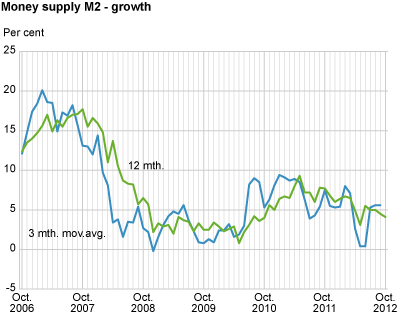Content
Published:
This is an archived release.
Decreased money supply growth
The twelve-month growth in total money supply (M2) was 4.1 per cent to end-October, down from 4.5 per cent to end-September. The decrease stems from households and municipal government.
The total money supply amounted to NOK 1 755 billion at end-October, up from NOK 1 739 billion at end-September.
Weaker growth in money supply for households
Households’ money supply constitutes more than half of the total money supply. At end-October it accounted for NOK 956 billion, down from NOK 960 billion the previous month. The twelve-month growth in households’ money supply decreased from 8.3 per cent to end-September to 6.7 per cent to end-October.
The growth in households’ money supply was lower than the growth in households’ gross domestic debt, which amounted to 7.1 per cent to end-October, according to the credit indicator C2 . For more information on the financial position of households, see the financial accounts in the national accounts .
Unchanged growth of money supply for non-financial enterprises
Non-financial enterprises’ money supply amounted to NOK 545 billion at end-October, up from NOK 533 billion at end-September. The twelve-month growth was -0.6 per cent to end-October, unchanged from the previous month. Non-financial enterprises’ money supply constituted 31.1 per cent of the total money supply and 39.7 per cent of their gross domestic debt measured by the credit indicator C2 at end-October.
Decrease in money supply growth for municipal government
Municipal government’s money supply amounted to NOK 73 billion at end-October, down from NOK 77 billion the previous month. The twelve-month growth rate was 4.4 per cent to end-October, down from 9.2 per cent to end-September.
Increase in growth for other financial enterprises
Other financial enterprises’ money supply amounted to NOK 182 billion at end-October, up from NOK 169 billion at end-September. The twelve-month growth was 6.1 per cent to end-October, up from -1.5 per cent the previous month.
| April 2012 | May 2012 | June 2012 | July 2012 | August 2012 | September 2012 | October 2012 | |||||||||||||||||||||||||||||||||||||||||||||||||||||||||||||||||||||||||
|---|---|---|---|---|---|---|---|---|---|---|---|---|---|---|---|---|---|---|---|---|---|---|---|---|---|---|---|---|---|---|---|---|---|---|---|---|---|---|---|---|---|---|---|---|---|---|---|---|---|---|---|---|---|---|---|---|---|---|---|---|---|---|---|---|---|---|---|---|---|---|---|---|---|---|---|---|---|---|---|
| M0 - 12 mth. | -0.4 | -19.7 | 1.9 | -19.2 | -18.2 | -10.5 | -20.7 | ||||||||||||||||||||||||||||||||||||||||||||||||||||||||||||||||||||||||
| M1 - 12 mth. | 3.4 | 0.7 | 4.8 | 2.2 | 3.4 | 3.2 | 1.1 | ||||||||||||||||||||||||||||||||||||||||||||||||||||||||||||||||||||||||
| M2 - 12 mth. | 4.9 | 3.1 | 5.5 | 5.0 | 5.0 | 4.5 | 4.1 | ||||||||||||||||||||||||||||||||||||||||||||||||||||||||||||||||||||||||
| M2 - 3 mth. moving average1 | 2.6 | 0.4 | 0.4 | 5.3 | 5.6 | 5.6 | |||||||||||||||||||||||||||||||||||||||||||||||||||||||||||||||||||||||||
| M2 households - 12 mth. | 7.7 | 8.1 | 8.3 | 7.5 | 8.1 | 8.3 | 6.7 | ||||||||||||||||||||||||||||||||||||||||||||||||||||||||||||||||||||||||
| M2 non-financial enterprises - 12 mth. | 0.7 | -3.5 | 1.7 | 2.5 | -0.1 | -0.6 | -0.6 | ||||||||||||||||||||||||||||||||||||||||||||||||||||||||||||||||||||||||
| 1 | Annualised figure. |
Composition of money supply
The broad monetary aggregate M2 amounted to NOK 1 755 billion at end-October, of which the major part, 92.9 per cent, consisted of bank deposits. In comparison, notes and coins only accounted for 2.6 per cent. The rest of the broad monetary aggregate consisted of shares in money market funds and certificates of deposits, which accounted for 4.3 and 0.3 per cent respectively.
Change in base money
Base money (M0) amounted to NOK 102 billion at end-October, up from NOK 99 billion the previous month. The twelve-month growth in M0 decreased from -10.5 per cent to end-September to -20.7 per cent to end-October.
Money market fundsData for money market funds has been updated back to January 2012. |
The statistics is published with Monetary aggregates.
Contact
-
Statistics Norway's Information Centre
E-mail: informasjon@ssb.no
tel.: (+47) 21 09 46 42

